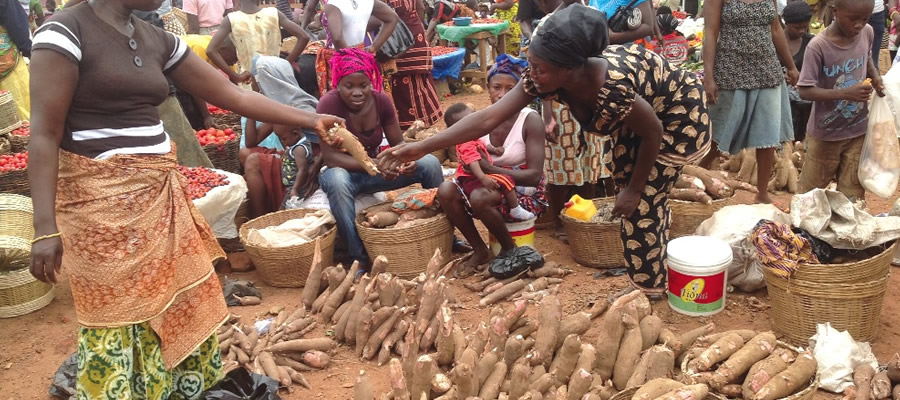

Poverty, Inequality and Social Protection
This section of the profile is an analysis of fundamental issues of vulnerability in relation to it contributory factors as well as its relation to some sections of the population such as women and children, persons with disabilities, PLHIVs, the extreme poor and the destitute. The district abounds with a number of factors that predispose its population to one risk or the other. Most of these factors are natural while others are manmade. Analysis of the current situation of the District revealed that drought or rain failure is one of the factors that predispose the people to the risk of food insecurity and can be prevented by introduction of irrigation and modern ways of farming and aquaculture.
Crop failure is common during years of drought and the people who are mostly peasant farmers suffer severe forms of hunger and malnutrition. Unlike the northern parts of the country where cattle, goats, sheep and poultry are kept as alternative social security against periods of drought, such arrangement is not the case in this district. Another important factor that can predispose the people to risk is river blindness also known as shistomiasis, which is caused by the black flies. Other phenomenon of significant threat to the people includes fire outbreaks. Sometimes a whole village is burnt down by either wild fires or hunters who are in search of game. The building pattern and the roofing materials in most of the communities including some of the food storages predispose the communities to the risk of fire outbreaks. In the absence of any proper mechanism for fighting fire, outbreak of fire can be devastating.
The combined effects of these factors make the district very vulnerable to acute food shortages, fire disaster, oncho infection and other diseases including HIV/AIDS. Women, children, the aged, the physically challenged etc are the worst affected. Women and Children are less resilient to the risk of acquiring sicknesses. Women lack equal access to productive resources such as land as their male counterparts. They are the least educated in the formal sector and the worst placed in terms of opportunities for alternative sources of employment. A further analysis of the social setups of the indigenous people reveals a sense of declining family ties and this has negative implications on the traditional social security system especially for the aged, the physically challenged, Orphans and persons infected with HIV/AIDS. There is a growing feeling of individualism among the people and this gradually weakens the social security system.
Disability
Persons with disability are defined as those who are unable to or are restricted in the performance of specific tasks/activities due to malfunctioning of some part of the body as a result of impairment or malformation. The total proportion of the population with disability in the district is over three percent (DSD, 2017). The district is prone to all the forms of disability including sight, hearing, speech, physical, intellectual and emotional impaired.
Disability has generally been stigmatized in Ghana, especially in traditional settings, where Upper Manya area is no exception. Parents of children with disability hide them from the eyes of the public. Persons with Disability (PWDs) would not usually be allowed to participate in some social activities. The well-being physical, emotional, psychological and social- of the PWD is affected by disability. Disability, therefore, constraints the movement of the elderly and reduces their interaction with others. These eventually results in social exclusion including participation in schooling.
Disability, Education and Literacy
Over three percent (2,317 persons) of the school going age population in the district (66,091 persons) constitutes persons with disability. Figure1. 8 shows persons with disability by their educational levels in the district. Most of the persons of the school going age have never been to school. As shown in figure 1.5, over one thousand two hundred persons with various forms of disability in the district have never attended school whilst less than fifty persons have attained primary school, senior high school or tertiary level (Degree).
Figure1. 8 Disability, Education and Literacy
Date Created : 11/27/2017 5:08:46 AM










 facebook
facebook
 twitter
twitter
 Youtube
Youtube
 +233 593 831 280
+233 593 831 280 0800 430 430
0800 430 430 GPS: GE-231-4383
GPS: GE-231-4383 info@ghanadistricts.com
info@ghanadistricts.com Box GP1044, Accra, Ghana
Box GP1044, Accra, Ghana